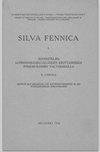泥炭地苏格兰松颗粒灰与松散灰施肥的比较
IF 1.7
3区 农林科学
Q2 FORESTRY
引用次数: 2
摘要
已经使用散灰研究了木灰施肥对森林泥炭地树木营养和生长的影响,但在实践中,几乎只使用颗粒状灰施肥。本研究比较了颗粒灰分和松散灰分(均为5 Mg ha-1)对富氮和贫氮条件下苏格兰松林分生长和营养的影响。在富氮场地,还比较了木灰与商业PK施肥。在富氮试验点,施用颗粒灰分和商业PK肥的15年间,平均林分增长量与未施肥对照处理相比增幅相同(平均为2.2 ~ 2.3 m3 ha-1 a-1)。然而,当使用松散灰分时,生长增长率高于对照(3.7 m3 ha-1 a-1)。在缺氮地,松散或粒状灰分(1.4 ~ 1.5 m3 ha-1 a-1)比未施肥对照的平均生长增加不显著。在两个地点施肥后的第一或第二生长季节,施用散灰或PK增加了叶面磷、钾和硼的浓度。在富氮区,颗粒状灰分比疏松灰分增加的叶面磷含量少。叶面磷、钾、硼浓度在初始升高后,在研究结束时呈下降趋势。在缺氮地,研究期结束时叶面磷浓度低于缺氮限度。本文章由计算机程序翻译,如有差异,请以英文原文为准。
Comparison of granulated and loose ash in fertilisation of Scots pine on peatland
The effects of wood ash fertilisation on tree nutrition and growth on forested peatlands has been studied using loose ash, but in practice, ash fertilisation is done almost exclusively with granulated ash. In this study, the effects of granulated ash and loose ash (both 5 Mg ha–1) on the growth and nutrition of Scots pine (Pinus sylvestris L.) stands were compared between a nitrogen-poor and a nitrogen-rich site over 15 years. On the nitrogen-rich site, wood ash application was also compared with commercial PK fertilisation. On the nitrogen-rich site, mean stand volume growth increase over unfertilised control treatment during the 15 year study period using granulated ash and commercial PK fertiliser was of the same magnitude (on average, 2.2–2.3 m3 ha–1 a–1). However, when loose ash was used growth increase over control was higher (3.7 m3 ha–1 a–1). On the nitrogenpoor site, the mean growth increase gained by loose or granulated ash (1.4–1.5 m3 ha–1 a–1) over the unfertilised control treatment was not significant. Fertilisation with loose ash or PK increased foliar P, K and B concentrations already in the first or second growing season, following fertilisation on both sites. Granulated ash increased foliar P concentrations on the nitrogen-rich site less than loose ash. After an initial increase, foliar P, K and B concentrations decreased at the end of study period. On the nitrogen-poor site, foliar P concentrations were below the deficiency limit by the end of the study period.
求助全文
通过发布文献求助,成功后即可免费获取论文全文。
去求助
来源期刊

Silva Fennica
农林科学-林学
CiteScore
3.50
自引率
11.10%
发文量
21
审稿时长
3 months
期刊介绍:
Silva Fennica publishes significant new knowledge on forest sciences. The scope covers research on forestry and forest ecosystems. Silva Fennica aims to increase understanding on forest ecosystems, and sustainable use and conservation of forest resources. Use of forest resources includes all aspects of forestry containing biomass-based and non-timber products, economic and social factors etc.
 求助内容:
求助内容: 应助结果提醒方式:
应助结果提醒方式:


